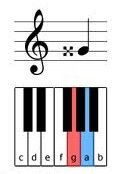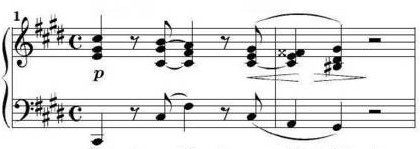 What are these X’s in my music? They look a little strange don’t they? Most likely what you are seeing is double sharps. Those little signs tell you to raise the pitch of a note two half steps or one whole step.
What are these X’s in my music? They look a little strange don’t they? Most likely what you are seeing is double sharps. Those little signs tell you to raise the pitch of a note two half steps or one whole step.
If you remember from an earlier lesson, one whole step equals two half steps. In other words, you would move to the right on the piano two keys.
For example, if you start on G and move up two half steps, you would land on A. G double sharp is really A!
 That’s exactly what I think when I read double sharps. I look at the note and play a whole step above.
That’s exactly what I think when I read double sharps. I look at the note and play a whole step above.
Here’s a list of double sharps to help guide you:
C double sharp = D
D double sharp = E
E double sharp = F#
F double sharp = G
G double sharp = A
A double sharp = B
B double sharp = C#
What if I have an F# in the key signature and a F double sharp is written in the music? What do I do now?
You have two choices:
1. Ignore the key signature and treat it as an F double sharp (G) by raising the pitch one whole step or,
2. Think of it as raising an F# a half step.
 When I see double sharps in my music, I prefer to not think about the key signature at all and just focus on raising the note written on the staff two half steps. This means following the two half step or one whole step rule of a double sharp, regardless of what sharps are in the key signature. I find this the easiest and least complex way of thinking about it.
When I see double sharps in my music, I prefer to not think about the key signature at all and just focus on raising the note written on the staff two half steps. This means following the two half step or one whole step rule of a double sharp, regardless of what sharps are in the key signature. I find this the easiest and least complex way of thinking about it.
Double sharps are used as a way of altering notes on the staff just like a sharp. The only difference is that a double sharp raises the pitch of a note two half steps instead of one. Don’t let these little X’s fool you. They are just as easy to learn as any other symbol in music.
